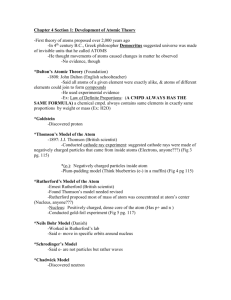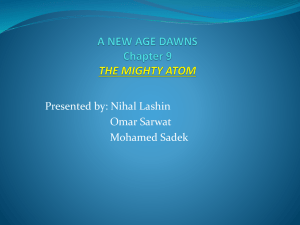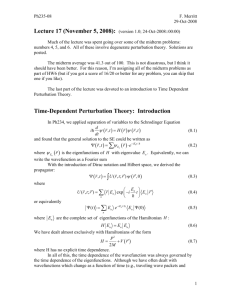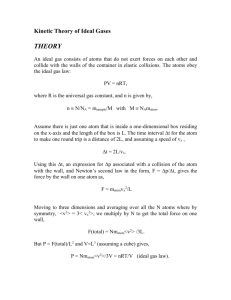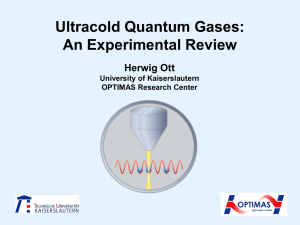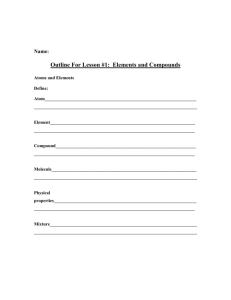Final Exam 2004
advertisement
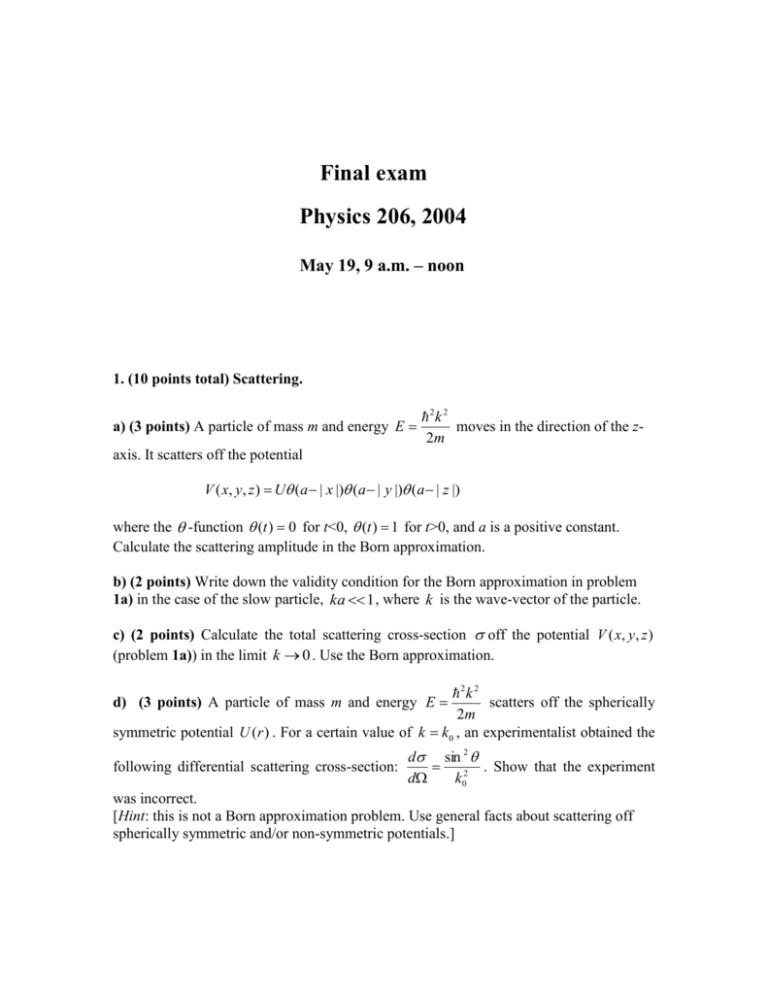
Final exam Physics 206, 2004 May 19, 9 a.m. – noon 1. (10 points total) Scattering. a) (3 points) A particle of mass m and energy E 2k 2 moves in the direction of the z2m axis. It scatters off the potential V ( x, y, z ) U (a | x |) (a | y |) (a | z |) where the -function (t ) 0 for t<0, (t ) 1 for t>0, and a is a positive constant. Calculate the scattering amplitude in the Born approximation. b) (2 points) Write down the validity condition for the Born approximation in problem 1a) in the case of the slow particle, ka 1 , where k is the wave-vector of the particle. c) (2 points) Calculate the total scattering cross-section off the potential V ( x, y , z ) (problem 1a)) in the limit k 0 . Use the Born approximation. 2k 2 scatters off the spherically 2m symmetric potential U (r ) . For a certain value of k k0 , an experimentalist obtained the d) (3 points) A particle of mass m and energy E following differential scattering cross-section: d sin 2 . Show that the experiment d k02 was incorrect. [Hint: this is not a Born approximation problem. Use general facts about scattering off spherically symmetric and/or non-symmetric potentials.] 2. (11 points total) Van der Waals forces. a) (1 point) The dipole moment of any atom in the ground state is zero. Verify this statement for the ground state of the Hydrogen atom (r ) exp( r / aB ) aB3 . Show ˆ that the average of its dipole moment operator d er is zero in the ground state. [ r Rel Rn , where Rel and Rn are the electron and nuclear coordinates.] ˆ b) (1 point) The dipole-dipole interaction of two atoms with dipole moment operators d1 ˆ and d 2 is described by the following contribution to the Hamiltonian: ˆ ˆ ˆ ˆ d d 3 ( n d1 )( n d 2 ) 1 2 Hˆ dd (*) 3 R where R is the distance between the atoms, n a unit vector in the direction joining the two atoms. For large R, the dipole-dipole interaction can be considered as a small perturbation. Show that the energy of the dipole-dipole interaction of the two atoms in their ground states is zero in the first order of the perturbation theory. [Hint: Since the ground state is nondegenerate, you can use the nondegenerate perturbation theory. Consider R as a classical variable, i.e. as a fixed parameter, and calculate matrix elements with respect to the wave functions of the electrons in the atoms.] c) (3 points) Consider a Hydrogen atom interacting with a metal wall. The interaction operator has the following form: ˆ 2 ˆ 2 d (n d ) Hˆ w 2(2 R)3 ̂ where d is the dipole moment operator for the Hydrogen atom, R the distance from the metal wall, n a unit vector perpendicular to the wall. Calculate the interaction energy in the first order of the perturbation theory for the Hydrogen atom in its ground state. Consider R as a fixed constant. d) (2 points) Use the second order perturbation theory to find the R-dependence of the dipole-dipole interaction energy for two atoms. The dipole-dipole interaction is described by Eq. (*). [Hint: Do not calculate any matrix elements. Just find how the interaction energy depends on R. Express your result in the form Edd R s . You should calculate s only. Do not calculate any coefficients.] e) (1 point) What is the distance dependence of the dipole-dipole force between two atoms? f) (3 points) Estimate the energy of the dipole-dipole interaction between two Hydrogen atoms in the ground state. The distance between the atoms R=0.5 nm. I am looking for a real, actual number here with correct units, not an abstract algebraic expression. Do not calculate any matrix elements. Just make an estimate. 3. (14 points total) Zeeman effect. a) (2 points) Consider a multi-electron atom in a weak uniform magnetic field B . The magnetic field is parallel to the z-axis. Write down the Hamiltonian. Neglect any relativistic effects such as the spin-orbit interaction. Consider the atomic nucleus as a point charge of an infinite mass. Take into account only the following contributions to the Hamiltonian: the kinetic energy of the electrons, the Coulomb interaction energy, and the interaction of the electron spins with the magnetic field. [Hint: remember that the kinetic energy operator depends on the magnetic field via the 1 vector potential A [ B r ] .] 2 b) (2 points) Neglect the terms proportional to the square of the magnetic field in the Hamiltonian you derived in problem 3a). Consider the terms linear in the magnetic field. Show that their sum is equal to ˆ | e | ˆ Hˆ 1 ( L 2S ) B 2mc ̂ where e is the electron charge, m the electron mass, L the total orbital angular ̂ momentum of the atom, and S the total spin of the atom. ˆ [Hint: show that [ A, pˆ ] 0 . Remember that L r pˆ .] c) (2 points) For any values of the quantum numbers J, L, and S, there are ( 2 J 1) atomic states with different z-projections M J of the total angular momentum. Use the result of problem 3b) and show that the energies of these states can be represented in the form E ( M J ) U + W BM J (**) where U and W are constants independent of M J . [Hint: use the first order perturbation theory and the Wigner-Eckart theorem. You do not have to calculate the constants U and W in Eq. (**).] d) (3 points) Calculate the constant W in Eq. (**) as the function of the quantum numbers J, L, and S. e) (2 points) An atom in a uniform magnetic field emits a photon of energy . The total angular momentum of the emitted photon is , i.e. J photon 1 . Assume that the quantum numbers J, L, and S of the atom do not change and only M J changes as the result of this process. How does the atom quantum number M J change? Express the frequency of the emitted photon via W. [Hint: use conservation laws.] f) (2 points) Sulfur has the following electronic structure: (Ne) (3s) 2 (3 p) 4 . Here (Ne) is shorthand notation for the filled neon-like core. Use Hund’s rules to determine J, L, and S. g) (1 point) You calculated the frequency of the emitted photon in problem 3e). Use that result and the result of problem 3f) and calculate the photon frequency for a Sulfur atom. The magnetic field B=1Tesla. I am looking for a real, actual number here with correct units, not an abstract algebraic expression.


